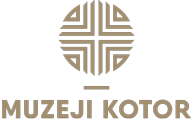The Municipal Public Institution “Museums of Kotor” is a group of the city’s cultural institutions, founded in 1992, which includes Perast City Museum, in Perast, The Church of St. Michael – Lapidarium, The Gallery of Solidarity and St. Paul’s Church (multimedia hall), all of which are located in Kotor and the Roman mosaics in Risan. The institution preserves, researches and presents, amongst other things, archeological finds of inestimable value from the Neolithic Prehistoric period, Risan’s Roman mosaics from the 2nd century AD, the most valuable of Kotor’s treasure including stone artefacts dating back centuries and millennia, the cultural heritage of Perast displayed in the city museum and the art fund Of the Gallery of Solidarity which was donated to our city after the 1979 earthquake.
Perast Museum
Perast Museum was established by the decision of the municipal authorities in 1937. The Museum holdings were mostly formed thanks to the donations of the inhabitants of Perast, heirs to the famous families, during the second half of the 19th and the second half of the 20th century. Besides the portraits of the famous inhabitants of Perast, weapons and other objects from the past of the Town, the Museum also holds rich archival material from the mid-15th century Perast. Visković Family Memorial has been a part of the Museum holdings as of 1970.
The Museum is housed in the most representative edifice in Perast, Captain Vicko Bujović’s 1694 Palace, which is considered one of the most renowned 17th century profane architecture edifices on the eastern Adriatic Sea.
Lapidarium
The objects of stone sculpture of Kotor Lapidarium make a singular group of monuments of our past, quite certainly the richest one in Montenegro and one of the most significant on the south-eastern coast of the Adriatic Sea. Present-day Lapidarium is located in the Romano-Gothic church of St. Michael on Cinema Square in Kotor Old Town.
The objects from the Classical and Late Classical period, then from the early Christianity, pre-Romanesque and Romanesque period, Gothic, Renaissance and Baroque period have been put on permanent display in the Lapidarium. The objects to be singled out are certainly those considered unique in the world, like the portrait of the Roman Emperor Domitian from 1st century A.D., Illyro-Roman cone-shaped cippuses (tombstones) from the 2nd to 3rd century A.D., fragments of the Early-Christian era, among which the one that stands out is the Agnus Dei relief, but also partly reconstructed stone church furnishings from the pre-Romanesque period. A large number of exceptionally decorated capitals ranging from the Classical period to the Baroque era are also exhibited there.
The Lapidarium also exhibits several coats of arms of the Venetian Town Governors and ancient noble families from Kotor and Perast: Pezzi, Beskuća, Drago, Paskvali, Magno, Bollini, Bembo, Buća, Bizanti, Vrakjen, Contareno and Visković.
Saint Paul’s Church
Pavle Bari, a citizen of Kotor had the St. Paul’s Church built in 1263 as his legacy.
Dominican Monastery, male one to start with, and as of the 16th century the female one, was established next to the Church. Blessed Osanna, a Kotor saint, saw the end of her earthly life there in 1565 walled up in her cell.
When the Church was turned into barracks during Napoleon’s occupation (1807-1814) its interior was divided in two levels by means of the floor system, so that the original character of a homogenous space completely disappeared. During Italian occupation in the World War II, it was turned into prison, while during the Cominform and the conflict between Tito and Stalin in 1948, this edifice became female prison, so called Little Prison.
This invaluable edifice was revitalized and adapted as a single exhibition museum space for the rich collection of stone monuments from the Town Lapidarium, and/or multi-purpose space for exhibitions, concerts, scientific meetings etc.
Gallery of Solidarity
After the earthquake that struck Montenegro in 1979, the activity was undertaken to collect works of art from the entire territory of the former Yugoslavia via former Association of Fine Artists. In this way Kotor acquired exceptionally valuable art fund called Gallery of Solidarity.
The art collection consists of more than 400 works of art (paintings, graphics, drawings, sculptures and photographs), as of 2011 located on the ground floor of the representative Renaissance-Baroque Pima palace, in Flour Square, in Kotor Old Town.
The fine art holdings of the Gallery of Solidarity constitute an important segment of culture of the Town of Kotor and Montenegro. One should not forget that Kotor is a town of monuments and huge cultural heritage, in which decades’ long shortage of modern art has been compensated for exactly by the establishment of the Gallery of Solidarity.
Roman mosaics
The Roman Mosaics archeological site in Risan is of outstanding importance from the Roman period. Within the complex are the remains of a villa and it’s floor mosaics dating from the 2nd century AD. This villa was a “villa urbana” a type of a city villa which stood out for its beauty, especially the floor mosaics, and is considered a representative example of Roman provincial architecture in this part of the Adriatic.
Risan Mosaics is a complex of 790m2. The villa is rectangular and has symmetrically arranged rooms. The central space is also rectangular and separated by a corridor around which are also rectangular, interconnected rooms.
